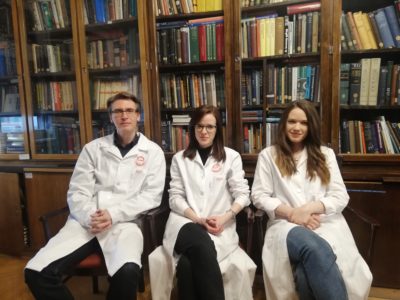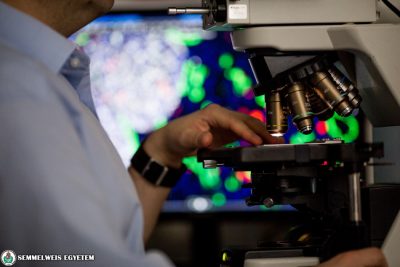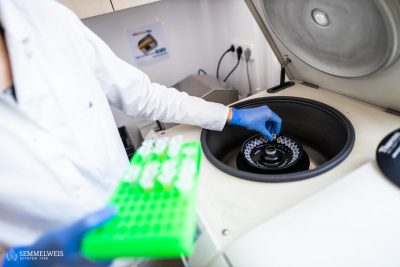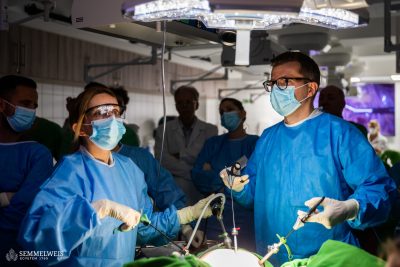The issue of resistant bacteria is one of the largest global health challenges. Researchers at Semmelweis University, in collaboration with a staff member from the Bolyai Institute of the University of Szeged, have developed an mathematical model that examines the relation between the infection causing gastric disorders and antibiotic resistance. Their study has recently been published in the prestigious journal Nature Communications.
 Gastric ulcer, duodenal ulcer, gastric cancer – these are serious diseases that may be caused by Helicobacter pylori (H. pylori) infection. The basic drugs used for the eradication of the infection include antibiotics containing the active substance called clarithromycin, a member of the macrolide family. In recent years, however, physicians have found that the failure rate of eradication treatments is due to the increasing prevalence of antibiotic resistance. In addition, this active substance or the similar, so-called macrolide-type antibiotics are also used for the treatment of several other diseases, which may also contribute to the increased prevalence of resistance. In order to find out why resistance develops, Dr. Gábor Lotz, associate professor of the 2nd Department of Pathology and Dr. Éva Kocsmár, a PhD fellow at the department, in cooperation with their colleagues examined fixed gastric tissue (biopsy samples) from H. Pylori-infected patients to identify the clarithromycin resistance of the bacteria. A detailed analysis was done on the macrolide dispensing data for the same patients (available through a prescription database of the National Health Insurance Fund) correlated with the frequency of resistance. The results showed that some patients had no record of taking a macrolide-type antibiotic, yet they were infected with a resistant bacteria (primary resistant infection).
Gastric ulcer, duodenal ulcer, gastric cancer – these are serious diseases that may be caused by Helicobacter pylori (H. pylori) infection. The basic drugs used for the eradication of the infection include antibiotics containing the active substance called clarithromycin, a member of the macrolide family. In recent years, however, physicians have found that the failure rate of eradication treatments is due to the increasing prevalence of antibiotic resistance. In addition, this active substance or the similar, so-called macrolide-type antibiotics are also used for the treatment of several other diseases, which may also contribute to the increased prevalence of resistance. In order to find out why resistance develops, Dr. Gábor Lotz, associate professor of the 2nd Department of Pathology and Dr. Éva Kocsmár, a PhD fellow at the department, in cooperation with their colleagues examined fixed gastric tissue (biopsy samples) from H. Pylori-infected patients to identify the clarithromycin resistance of the bacteria. A detailed analysis was done on the macrolide dispensing data for the same patients (available through a prescription database of the National Health Insurance Fund) correlated with the frequency of resistance. The results showed that some patients had no record of taking a macrolide-type antibiotic, yet they were infected with a resistant bacteria (primary resistant infection).
In order to reveal the source of these primary resistance cases, Dr. Gergely Röst, mathematician at the Bolyai Institute of the University of Szeged, in collaboration with research physicians, set up a new epidemiological model. He examined the resistance status of 4,744 patients and their previous macrolide antibiotic consumption. The model lists in detail the transmission potential (transmission pathways) of antibiotic-sensitive and resistant H. pylori with equations, thus showing the spread of infections by considering the drug consumption in the population dynamics. The model is suitable to cast light on underlying unknown parameters such as primary resistance. Calculations have shown that the vast majority of these patients were already infected with the resistant bacteria (so in their case, the pathogen is likely to be resistant due to another person taking antibiotics). Epidemic dynamics have also shown that reduced consumption of macrolides for other diseases would reduce resistance to future antibiotic treatments in the case of H. pylori.
“International examples also show that rationalizing the indications for antibiotic treatments may significantly reduce antibiotic consumption and mitigate the further increase in resistance in the population”, explained Dr. Gábor Lotz.
As Dr. Gábor Lotz emphasized, the spread of resistant bacteria is one of the largest global health challenges. Such research greatly contributes to the development of treatment protocols that reduce this risk. The research is also a great example of how collaboration between physicians and mathematicians can lead to valuable, new scientific results.
The publication has recently been published in the prestigious journal Nature Communications.
Kocsmár, É., et al. Primary and secondary clarithromycin resistance in Helicobacter pylori and mathematical modeling of the role of macrolides. Nat Commun 12, 2255 (2021). https://doi.org/10.1038/s41467-021-22557-7
https://www.nature.com/articles/s41467-021-22557-7
Ádám Szabó
Source: Dr. Gábor Lotz, 2nd Department of Pathology
Photo: The Nature Portfolio Microbiology Community; the photo was taken by the author
Translation: Katalin Illés-Romhányi


